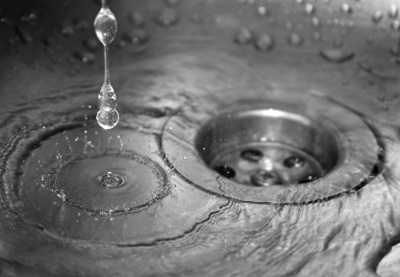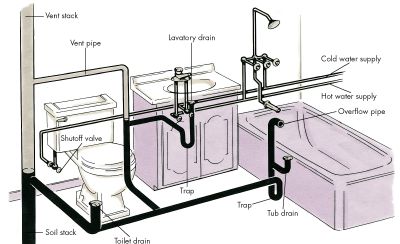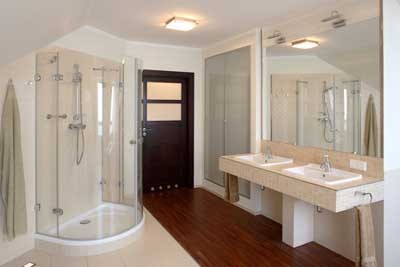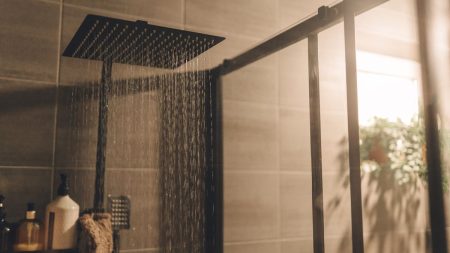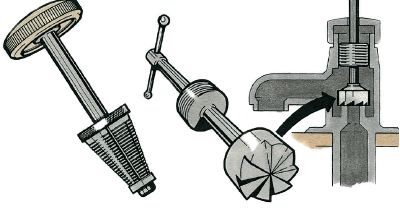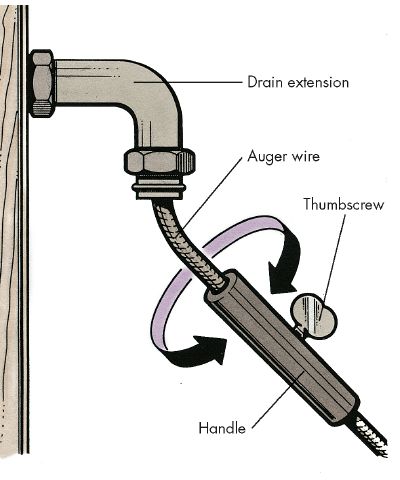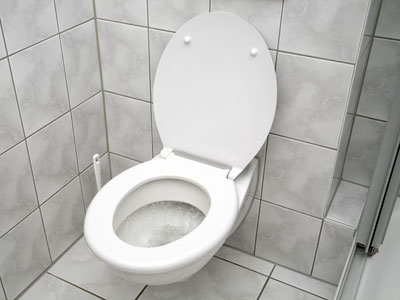Directly beneath the drain outlet of every kitchen sink and every bathroom lavatory is a trap. This element is vital not only to the proper functioning of the drainage system but also to your health and safety. Each drain trap contains and maintains a plug of water within its curved section that seals against the entrance of harmful sewer gases. If the drap trap leaks, this water barrier may disappear and create a hazardous situation. All drain traps must be kept in proper working order. Restrictions and clogging are immediately noticeable because the drainage flow is slowed or stopped. Clearing the blockage takes care of the problem. Leakage or seepage can often go undetected for a while, so check your traps from time to time and make quick repairs if anything seems wrong.
Drain trap assemblies have several parts. The short piece of pipe that extends downward from the drain outlet flange in the sink or lavatory is called the tailpiece. The curved section of pipe connected to the tailpiece is the trap itself. The trap may be either one piece or two coupled sections. The piece of pipe extending from the end of the trap to the drainpipe outlet in the wall or floor is the drain extension. All of these pieces may be made of rather thin metal that is subject to corrosion, seal failure, and mechanical damage. Damage can also result from reaming with a plumbers’ auger. Whatever the reason for failure, a malfunctioning trap should be repaired immediately.
Sometimes the problem is simply that the slip nuts holding the drain trap assembly to the drain and the drainpipe have loosened. Tightening them may solve the problem. But if the metal has corroded through, if the slip-nut threads are damaged, or if other damage has occurred, the only solution is replacement. Drain trap assemblies and parts to fit just about any possible installation requirement are readily available at most hardware and all plumbing supply stores. Chrome-plated thinwall brass traps are popular, especially where appearance is important. Polypropylene (PP) plastic traps, notable for their ruggedness and longevity, will outperform all other types. ABS plastic traps are also in use, but they become deformed and eventually fail when forced to handle frequent passage of boiling water and caustic household chemicals. In addition, they may not be allowed by your local plumbing code. Ask the plumbing clerk at your local building materials retailer for recommendations.
Whatever the material, there are typically two trap diameters: 11/2-inch traps for kitchen sinks and 11/4-inch traps for lavatories. Take the old trap with you when you buy the new one; if possible, also take the old tailpiece and drain extension. In most cases, trap replacement is simple. Here’s how:
Step 1: If trap is equipped with cleanout plug on bottom of curved section, remove plug with wrench and let water in trap drain into bucket. Otherwise, unscrew slip nuts and slide them out of the way.
Step 2: If trap is a swivel type, curved trap section(s) will come free. However, keep trap upright as you remove it, and pour water out after part is free. If trap is fixed and does not swivel, remove tailpiece slip nut at drain flange and slip nut at top of trap. Shove tailpiece down into trap itself, then twist trap clockwise until you can drain water in trap. Pull tailpiece free, and unscrew trap from drain extension or drainpipe.
Step 3: Buy drain trap of proper diameter, new tailpiece, drain extension, or other fittings, as necessary. A swivel trap is the easiest to work with because it can be easily adjusted for angled or misaligned drainpipe/fixture installations. A clean-out plug on a trap is handy so trap can be cleaned out without removing it.
Step 4: Replace parts in appropriate order, making sure you have slip nuts and compression seals, or large washers, lined up on the proper pipe sections. Couple parts together loosely with slip nuts, make final adjustments for correct pipe alignment, and tighten nuts snugly but not too tight. Plumbers’ joint tape or compound is not usually necessary, but you can use either.
Step 5: Run water into new trap immediately, both to check for leaks and to fill trap with water to provide that all-important barrier against sewer gases.
Whatever type of drain repair is needed, it’s best to address it as quickly as possible. Otherwise, you may wind up with a big problem on your hands — and all over your floors.
Read the full article here
